How to Buff Your Car:
Start by asking the right question
You want to know how to buff your car — but do you really want to buff your car or do you really just want shiner paint?
I am willing to bet what you are really after is shinier car paint. So you go in search of tips on how to buff your car and you read review after review on the best car buffers and the best car polish, but when it comes down to it all you really want is shinier car paint.
Unfortunately you are living in a world that I refer to as "information overload". You have so much free information at your finger tips that you become overwhelmed with way too many opinions and you never really get any closer to what you are after:
"Neck turning, retina blistering shine on your car paint!"
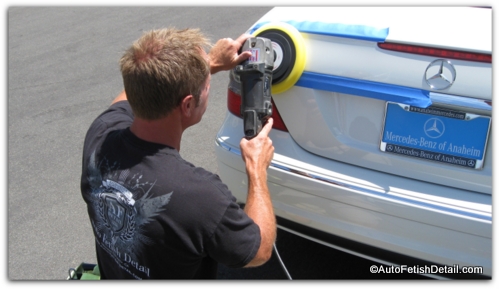
The industry knows that most people chasing a high-gloss finish lack the experience to ask the right questions. They’ll happily answer your basic inquiries in a way that gets their polish into your hands—and your money into their pockets.
How to Buff Your Car:
What you probably already know
I think it is safe to say that you likely accept that in order to make your car paint shinier, you will need to buff your car. But buffing a car is a massive generalization!
My goal is to help you know how to buff your car with tips and recommendations that will simply your life of car care and do so in a safe and efficient manner.
- Do you buff your car by hand or with machine?
- Should you use a car polish or a compound?
- What is the difference between a compound and polish anyways?
- What is the best way to buff a car?
- How does car polishing actually work?
Now
that I have laid out a few questions that I have found most people
don't necessarily think of, I will answer them in a more appropriate
order that should bring far more understanding for you!
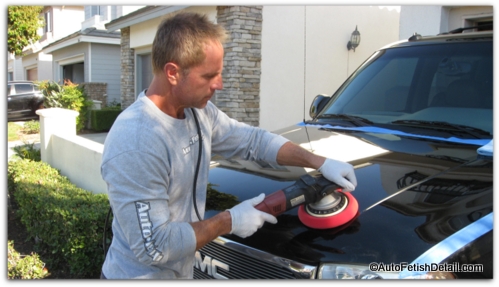
Paint Enhancement vs. Paint Correction
Here's another question you likely haven't considered and will probably never be asked by someone trying to sell you the next best car polish or rubbing compound.
What is the difference between paint enhancement and paint correction?
Think of it this way:
- Paint enhancement is a way to enhance the appearance of your car paint but on a temporary basis.
- Paint correction is using abrasive and chemical technology to refine the paint surface to create a more "perfect" reflective surface that is more "permanent" —nothing in life is truly permanent, but paint correction is permanent within the context of this discussion.
Paint Enhancement: You can use a very basic car polish with no abrasives, or simply apply some wax to make your car look shinier.
If you are motivated but not committed to this process of polishing your car, then all you really need to do is 3 things:
- Wash your car
- Decontaminate the paint using a clay bar
- Apply a quality wax or sealant
Paint Correction: If you accept that polishing is going to deliver the results you really want —permanently, then this is what you will need to do:
- Wash your car
- Decontaminate the paint with a clay bar
- Polish the paint with a quality car polish using a machine polisher
- Finish with a coat of wax, sealant, or ceramic coating
How Does Car Polishing Actually Work?
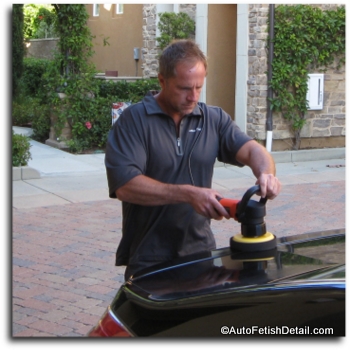
To "permanently" fix your car paint, you need to scratch it.
Yes, you read that right!
What you need to know is that not all scratches are created equal. I am not talking about all the unwanted scratches your car likely already has. I am talking about using compounds/polishes that contain abrasive particles in them to scratch away paint flaws and imperfections, as well as restore some additional depth and shine before you apply some form of car wax or paint sealant.
"You will literally scratch your way to success!"
The official term of the kind of polishing you need to do to your car is mechanical polishing. This simply means that you use an abrasive material to eliminate or diminish the imperfections of your car paint.
When it comes to polishing your car, these types of abrasives will be found in the endless choices of car polishes and compounds. Your brain might begin to melt at this point at the thought of trying to find the best car polish in which to buff your car, but don't worry! I will be covering that also.
What is the Difference Between Compound and Polish?
I start with this question as it is a common one and one you will need to know moving forward. The simple answer is this:
Compounds are more aggressive forms of products used for polishing. Compounds have more aggressive types of abrasives and are used for what you can call the "heavy lifting" of car polishing.
Polishes are made with finer abrasives or no abrasives at all. There are "polishes" that rely on chemicals to perform the "polishing" that can enhance shine without using any type of abrasives. These "chemical only" car polishes are very limited in their ability to do any real significant change to your paint surface in restoring shine, depth, and gloss.
Since we want to create some lasting shine to your car, you will need a car polish with some form of abrasives engineered into the product.
Is it Better to Polish Your Car by Hand or Machine?
There really is no right or wrong answer, just a question of what type of results will meet your expectations.
So let's analyze the pros and cons of each possibility:
Polish Car by Hand
- No equipment needed
- All you have to do is rub until your shoulder, elbow, and wrist wants to fall off!
- The results will be inconsistent from section to section
- Your body will never be capable of duplicating the consistent speed and movement that can be achieved with machine polishing
- Less fear when compared to polishing with a machine —especially if this is your first time to polish a car
Polish Car by Machine
- Additional cost in purchasing a car buffer
- A learning curve to use the car buffer (don't worry; it is far easier than you think)
- Capable of achieving dramatically better and lasting results than polishing your car by hand
- Will actually be quicker than trying to polish a car by hand
- An ability to polish your car evenly with consistent speed and movement of polishing pad
How to Buff Your Car:
What Would Darren Do (WWDD)
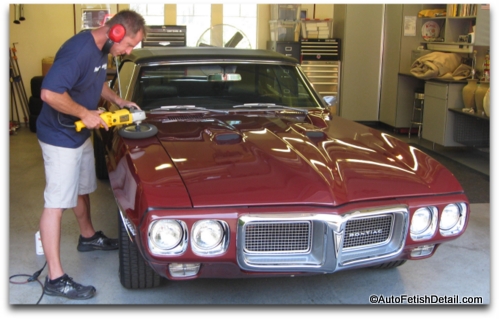
I would keep things super simple —especially since polishing your car may literally be a one-time-only event.
This is true —polishing your car paint is not like waxing your paint where you need to keep doing this over and over again.
We are going to keep things super simple by shopping for a car polishing kit that will contain everything you need to create that award winning shine.
Adam's Swirl Killer Polishing Kit
Adam's Swirl Killer Kit on Amazon
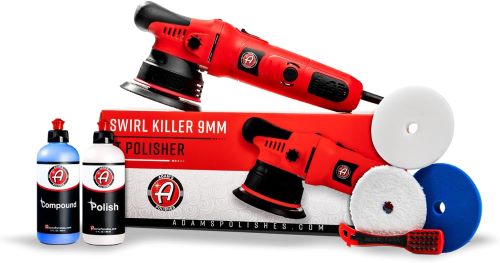
- True professional grade car buffer ideally suited for all levels of experience, or no experience at all!
- If you have the budget and are committed to a comprehensive car polishing kit
- Everything needed (even detailing clay) to raise the shine on your car paint to a level you never thought possible
Darren's Tips: This car polisher feels great in my hands, has plenty of power. Not only does this buffing kit come with everything needed, but it provides a winning balance between cost, performance, and quality without over-paying like you could with a few other brands of car buffers.
Micro Fiber Detailing Cloths
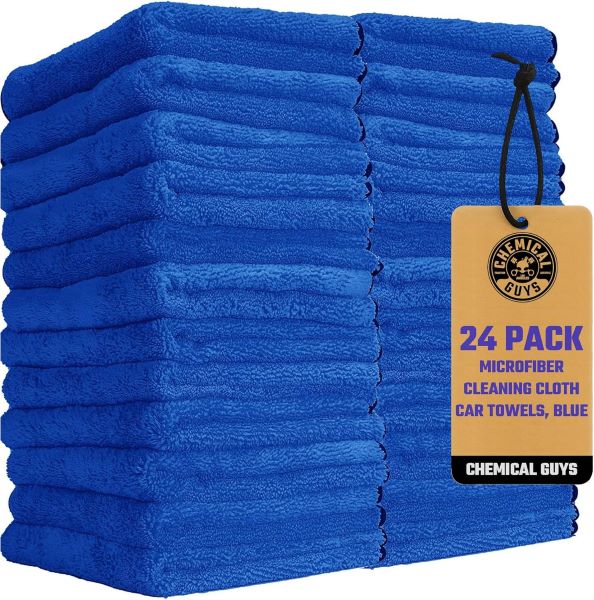
Chemical Guys Microfiber Cloths on Amazon
- You will need some quality micro fiber cloths to remove the polish as you are buffing your car
- Not all micro fiber cloths are created equal; these represent a great balance in quality, thickness, and cost when it comes to how you buff your car.
- A pack of 24 might seem overkill —microfiber cloths are the superior cloth for any task so you will always have plenty of need for extras.
The Steps of How to Buff Your Car
Due to the endless opinions on the how to buff your car, I am going to break it down for you in hopes of helping you not only take that initial first step, but perform at a level that you would not likely ever think possible.
- Work on a clean paint surface only (clean in this moment simply means a freshly washed car to remove what I call the superficial dirt)
- Decontaminate your car paint to remove embedded/bonded paint contaminants (this is the process commonly called claying your car using detailing clay. If you swipe your hand face down across the surface of your car paint, you will likely feel tiny specs of dirt that seem to be stuck to your car paint. This is simply what happens when air pollutants of any kind settle onto your car paint and begin to etch into the paint. While it is absolutely possible to buff your car without removing [decontaminating] these tiny specs of dirt, removing these bonded contaminants will not only deliver better final results, but make the car buffing process easier as the pad and polish will not get resistance from these tiny, bonded contaminants.
- Gather all the tools/products needed: car polish, car polisher, polishing pads, and micro fiber cloths.
- Assemble your equipment, pads, and polishes into a working area.
- Although you can use most car polishes in direct sunlight by finessing the moment, it is always best to work on a shaded surface of your car paint.
- How to buff your car from section to section is entirely up to you, but as a rule you will want to buff your car working on the top surfaces first, while working your way down the car (this means you start at the highest surface areas first so you don't lean on your freshly polished side panels as you try and reach across your roof or hood to polish these higher areas of the car)
- Apply the polish to the polishing pad by applying 7-10 pea sized amounts evenly spaced on the pad surface —this is how much I recommend to begin with. As you move forward, you will require a little less polish each time as your pad becomes more and more saturated —this does not mean you allow your pad to become over saturated either— you will clean your pad as you work forward.
- If you are a true beginner and overly fearful, simply start with less speed and less pressure when first learning how to buff your car. As you gain experience you will be able to make adjustments so as to produce your desired results.
- The more speed, the more pressure, the stiffer the polishing pad, and the longer you polish a specific area will produce more paint correction abilities. The opposite is also true if you lack the experience to know what you are doing at the beginning.
- The dual action polisher from above is the safest type of polisher you can every use. You would have to try and do damage with this buffer due to how user-friendly and safe it really is. Be mindful as you are working that the polishing head is both spinning and vibrating. Often you will "stall" the spinning of the polishing head if you apply too much pressure. The machine will continue to vibrate, but once it stops spinning, you will no longer be utilizing the full potential of the buffer. This will not damage the car paint you are working on, but you have just limited yourself. How to buff your car is about awareness and understanding all the moving parts of the car polishing process. You will not learn overnight; but once again, you are able to safely ease into this part of the detailing process knowing you are doing it in a very safe way.
Darren's Tips: I understand that if this is your very first time and are just beginning to learn how to buff your car you may be overly cautious. Just know that with any of these buffers, polishes, or polishing pads on this page, it would be very difficult to actually damage your car paint. You may become frustrated as a beginner like most of us naturally will, but you can be assured that you do not need to be overly concerned about doing any actual damage to your car paint.
How to Buff Your Car by Hand
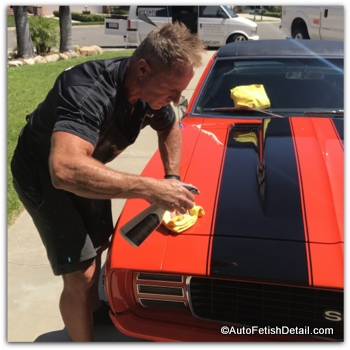
Too many guys are scared to use a polishing machine because of myths spread by people with little hands-on experience. Sticking to old-school, all-hand methods will always cap how good your finish can get—nobody can match a machine’s consistent speed, pressure, and pattern by hand.
Machines have taken over every industry for good reason: they’re simply more effective.
If hand buffing were truly superior, we’d still rely on it exclusively. But if you insist on going old-school, here are my recommendations for a quality car polish:
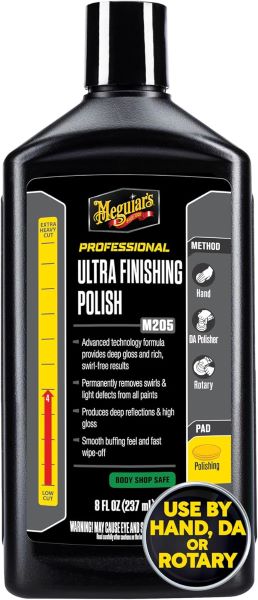
Meguiar's Ultra Finishing Polish on Amazon
- Achieve a mirror-like finish – advanced technology delivers deep gloss and rich, swirl-free results worthy of a luxury vehicle
- Eliminate swirls for good – permanently removes light defects and swirl marks to reveal a flawless deep shine Ignite brilliant reflections – professional-grade polish creates stunning, high-gloss clarity without any cleanup hassle
- Effortless application – works with rotary, DA polisher, or by hand; goes on smoothly and wipes off in seconds for a quick, refined result
Polishing Your Car by Hand
Now it's time to rub your paint until your arm wants to fall off:
- Use either a micro fiber cloth, or a micro fiber pad to do the hand polishing with
- The natural way for a person to polish is in circular motions. You will hear endless opinions as the proper way to polish a car by hand. Ultimately you are going to have to figure this one out on your own due to so many variables that will make your situation totally unique: what type of paint you are working on (single stage or two stage clear), what color is the paint, how damaged is the paint, what is your intent for polishing your car (develop more overall shine? remove scratches?). This means you may find that circular motions overall is effective, but you may happen upon a scratch and need to really lay into the scratch in order to remove/diminish the scratch with strong back and forth movements, then transition into a lighter, circular polishing pattern. Once again; you will have to decide on the most appropriate way in which to buff your car based on the results you are observing as you begin to work.
- Polishing in circular motions do not produce swirl marks. I know you have heard this a 1,000 times, but it just isn't true. Yes, you are developing a "scratch pattern" using any type of polish, but the only reason scratches show up in a swirl type pattern is due to the sun being circular and highlighting any and all scratches in a matching circular shape.
- I recommend keeping a dedicated microfiber cloth for removing the polish. Don't be cheap and use the same microfiber to both polish and remove.
In closing, give yourself a break and accept that everything has a natural learning curve to it. It is unrealistic to think you will perform at the same level as a veteran detailer like myself when you first learn how to buff your car.
But if you stick with it and put in a little time and patience, you will quickly adapt and learn the skills to produce a shine on your car that will impress both you and anyone else who looks at your car!
I hope this has helped in your first attempts of how to buff your car!
Sincerely,
Darren Priest
|
|
